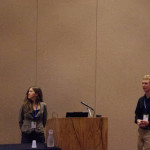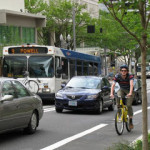Slow down.
Stay safe.
Such a simple message—and one we can’t quit repeating if we’re going to keep our Neighborhood Safe Streets Bill moving forward.
If you feel as if you keep hearing from us on the same issue, you’re right. Every bill that becomes a law has committee hearings and floor votes in House and Senate, with the governor’s desk as the final stop. We’ll make sure you know of each opportunity to speak up for a bike-friendly Washington, whether it’s supporting a good bill or trying to amend or kill a bad idea.
 HB 1045, the Neighborhood Safe Streets Bill, should be coming to the floor of the House for a vote Feb. 18 or 19. It’s time to ask your legislators to vote yes for safer streets, less red tape, and cost savings for taxpayers.
HB 1045, the Neighborhood Safe Streets Bill, should be coming to the floor of the House for a vote Feb. 18 or 19. It’s time to ask your legislators to vote yes for safer streets, less red tape, and cost savings for taxpayers.
You’re with us on this. Now what?
Contact your legislator. Enter your mailing address on the district finder form (choose Legislative, not Congressional) and follow the instructions on the site to reach a contact form.
Choose your state representatives and ask for a YES vote on the floor for HB 1045.
Reasons this bill contributes to better biking, better neighborhoods, and better government:
HB 1045 is about local control, increasing government efficiency by cutting red tape and expense, and making neighborhood streets safer. This bill does not lower speed limits by itself; it simply gives cities and towns the option to lower speed limits to 20 miles per hour on nonarterial streets without the current requirement for conducting a traffic and engineering study.
HB 1045 has bipartisan support. The Senate companion bill (SB 5066) just passed out of the Senate Transportation Committee with unanimous “do pass” support. In the previous biennium, this legislation passed out of the House 92-0 and 96-0. This is the year to get it done!
HB 1045 can save cities and towns money by removing the requirement for an engineering study. It’s smart policy that removes unnecessary regulation over a 5 mph decrease (typically, the de facto non-arterial speed is 25 mph in towns and cities). This change lets cities spend that money on actually making safety and traffic improvements instead of conducting another “make work” study. Traffic and engineering studies cost $1,000-5,000 for cities with in-house staff and even more for cities that have to hire consultants to conduct the studies.
The elderly are most vulnerable to collisions at speeds above 20 MPH. As we look to create safe neighborhoods for our increasingly elderly population, slower streets are more forgiving to those whose mobility is affected by the highly individual process of aging. Design practices that explicitly recognize aging will better serve a growing segment of the nation’s population. This is why AARP Washington is on the long list of supporting organizations.
Safe, walkable streets are important for safety and livability, and they improve the quality of our schools—so kids can walk and bike and so parents can feel safe sending their kids to school. This is why so many of our partners on Safe Routes to School support this bill.
This bill could be an especially helpful tool in the toolbox of cities and towns to reduce cut-through traffic on neighborhood streets. An application of this legislation could be to reduce “cut-through traffic” off of arterials and onto non-arterial streets, which affects property values, safety, and livability in cities and towns across Washington.
What else is cooking in the legislature?
We’ll keep bird-dogging this bill along with the others on our bike advocacy priority list:
- increase funding for bike/pedestrian projects including Safe Routes to School, Complete Streets, and the Bike-Pedestrian Safety and Mobility Program
- make sure any proposed transportation revenue package includes healthy funding levels for active transportation
- fight a proposed new fee on the sale of bikes that might get included in a revenue package
- protect the requirement that teen drivers get bike/pedestrian safety education in driver’s education against the threat of repeal
- find funding to study the best ways to transport students, such as getting more kids walking, biking, and using public transit while we save schools money
- support inclusion of health as a policy goal for the state transportation system
- and whatever else comes along that can help—or hurt!—bicycling in Washington.
Our Legislation & Statewide Issues page lists the issues and bills we’re following so bookmark that, follow us on Twitter, like us on Facebook, and sign up for our email Action Alerts to keep pace with the session as it speeds up.
Stay tuned and stay active!
Related Reading
- Neighborhood Safe Streets Bill: Second Gear, Second Committee Hearing
- Neighborhood Safe Streets Bill: First Gear, First Committee Hearing
- Take Action for Safer Neighborhood Streets
- Love Bikes? Take Action During Valentine’s Week!
- Week 3 Legislative Update




One Comment
Congratulations and good job, Bicycle Alliance!
Your bill idea came to me when I was a very fresh (i.e. newly elected) legislator. It was the very first Freshman bill to pass in the House of Representatives in the 62nd Legislature, on Feb. 7, 2011 with unanimous vote. Since then, it passed the House again in 2012 and 2013.
Finally, in the final minutes, it passed nearly unanimously on the Senate Floor as the last policy bill before cutoff earlier today.
Thank you for this great bill idea. Thank you for your unflinching support and best wishes to everyone. It’s been quite a 3-year ride.
Rep. Cindy Ryu, 32nd LD